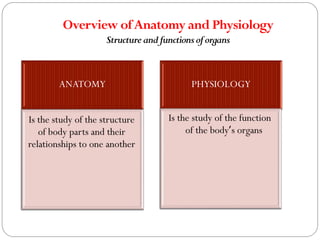Human Anatomy and Physiology-Introduction.pdf
- 1. Human Anatomy and Physiology Dr. Jackson Achankunju M.Sc,M.Ed,M.Phil,PGDEPMA,Ph.D Email: jacksonachankunju@gmail.com ŌĆ”.an over view
- 2. ANATOMY Is the study of the structure of body parts and their relationships to one another PHYSIOLOGY Is the study of the function of the bodyŌĆÖs organs Overview ofAnatomy and Physiology Structureandfunctionsoforgans
- 3. Overview of Anatomy and Physiology
- 4. ANATOMICAL TERMS DIRECTIONAL TERMS 4
- 5. 5
- 6. 6
- 7. 7
- 8. Regional terminology ŌĆ½ž¦žź┘ä┘é┘ä┘Ŗ┘ģ┘ŖŌĆ¼ ŌĆ½ž¦┘ä┘ģžĄžĘ┘䞣ž¦ž¬ŌĆ¼ 8
- 9. AxialAxial ŌĆō head, neck, and trunk AppendicularAppendicular ŌĆō appendages or limbs 9
- 13. 13
- 15. ’éŚ Anatomy -The study of the structure of body parts and their relationships to one another. ’éŚ Physiology -The study of the function of living organisms. 15
- 16. Interdependence of Anatomy and Physiology ’éŚ Structure and function are interrelated ’éŚ The function of a structure implies that function is dependent upon structure ’éŚ Anatomy and physiology are truly inseparable sciences ’éŚ In architecture ŌĆ£form follows functionŌĆØ ’éŚ A description of anatomy is followed by an explanation of its function, the structural characteristics contributing to that physiologic function 16
- 17. Branches of Anatomy Gross Anatomy The study of large body structures visible to the naked eye Regional Anatomy The study of all structures (blood vessels, nerves, muscles) located in a particular region of the body Systemic Anatomy The gross anatomy of the body system by system Surface Anatomy The study of internal body structures as they relate to the overlying skin Microscopic Anatomy The study of structures too small to be seen without the aid of a microscope Developmental Anatomy The study of changes in an individual from conception to old age 17
- 18. Branches of Anatomy ’éŚ Embryology ’éŚ The study of the developmental changes that occur before birth 18
- 19. Specialized Branches of Anatomy ’éŚ Pathological anatomy ’éŚ The study structural changes in cells, tissues, and organs caused by disease ’éŚ Radiographic anatomy ’éŚ The study of internal body structures by means of x-rays and imaging techniques ’éŚ Functional morphology ’éŚ The study of functional properties of body structures and efficiency of design 19
- 20. Hierarchy of Structural Organization ’éŚ Chemical ’éŚ Cellular ’éŚ Tissue ’éŚ Organ ’éŚ Organ System ’éŚ Organism 20
- 21. Structural Organization ’éŚ Chemical Level ’éŚ At the chemical level atoms combine to form small molecules (CO2 and H2O) and larger macro molecules 21




















